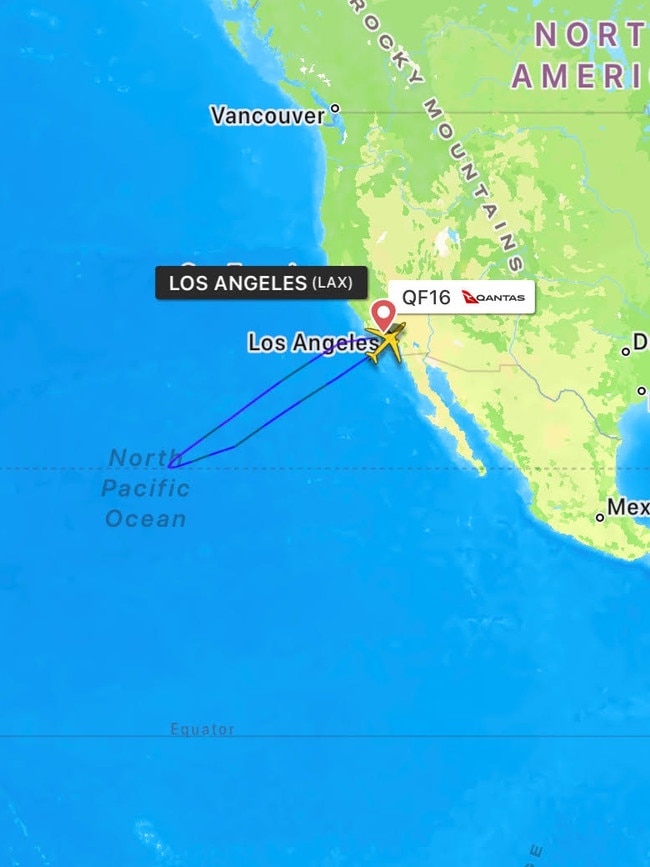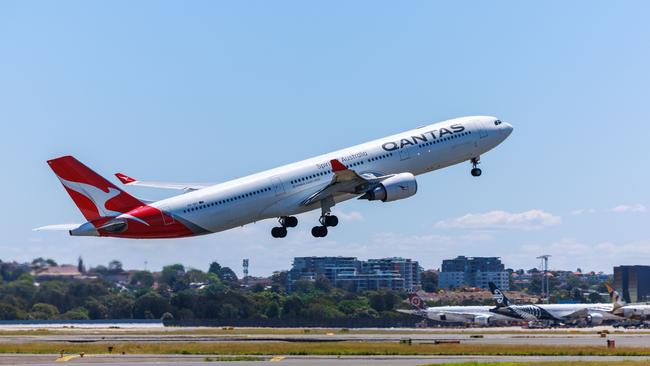ATSB investigation launched into Qantas’ six hour flight to nowhere
A six hour Qantas flight to nowhere is under investigation by ATSB as the airline suffers more drama and a turn back to Brisbane.
Business
Don't miss out on the headlines from Business. Followed categories will be added to My News.
An investigation has been launched into a Qantas flight that turned back to Los Angeles three hours into its trip to Brisbane after an engine malfunction.
Flight QF16 was in the air for just over 6 hours in total, before passengers returned to where they started on December 4.
The Australian Transport Safety Bureau is investigating the incident as an engine malfunction on the A330-200 registered VH-EBQ.
According to the investigation brief, “sparks were observed from the number two engine during the cruise, prompting the decision by pilots to turn back to LA”.
“During approach, a bang was heard and the crew detected number two engine stall indications,” said the ATSB.
“The engine remained idle for the remainder of the flight.”

A post-flight engineering inspection revealed evidence of metal in the tail pipe of the engine in question.
The investigation comes as another Qantas flight was forced to turn back to Brisbane less than an hour into a service to Adelaide on Tuesday, after a problem with the landing gear brakes on the Embraer 190 jet.
Passengers told radio 4BC they were instructed by cabin crew to “keep their heads down” for the landing with fears the locked brakes would cause the tyres to blow on impact.
Applause broke out when the jet landed back in Brisbane with emergency services on standby.
A Qantas spokeswoman said they understood it would have been a distressing experience for customers.
“We thank them for following the instructions of the crew. We are working hard to get customers on their way as quickly as possible,” said the spokeswoman.
“We will follow up with all customers to provide our support.”
It comes after a rough month for Qantas, which saw a Boeing 737-800 experience engine failure on takeoff from Sydney Airport on November 8.
Hot metal debris expelled from the right engine’s tailpipe started a grassfire along the runway and pilots circled over Sydney and Botany Bay for a short time before returning to Sydney on one engine.
Video of the engine in question showed damage to the turbine blades, and an investigation by the ATSB was continuing.

The transport safety regulator also recently reported on another incident involving Qantas, that revealed a 1.25m tool was left in an engine of an A380 by maintenance engineers in Los Angeles for a month.
The nylon tool was found wedged inside the engine during a maintenance check on January 1, after spending 294 flying hours in the low pressure compressor case, during which the superjumbo had made several trips across the Pacific.
The ATSB’s final report on the incident highlighted that maintenance engineers failed to identify the tool in the engine during checks for foreign objects, and nor was a missing tool report filed.
“Foreign object debris and damage can pose a significant threat to the safe operation of aircraft, which is why regulations, procedures and training are in place to limit the risk of foreign object damage, especially from introduced objects during maintenance,” said ATSB chief commissioner Angus Mitchell.
“Correctly applying tool control is fundamental to mitigating against any human errors that may arise.”
In 2021, the ATSB identified a screwdriver tip had been left in the engine of a Jetstar A320 during maintenance, resulting in an aborted takeoff from Brisbane Airport when flames were seen from the right engine.
Qantas A330s are maintained at the airline’s Brisbane engineering depot and not in Los Angeles.
More Coverage
Originally published as ATSB investigation launched into Qantas’ six hour flight to nowhere





